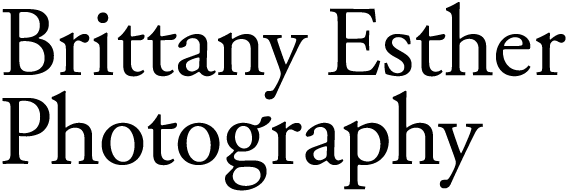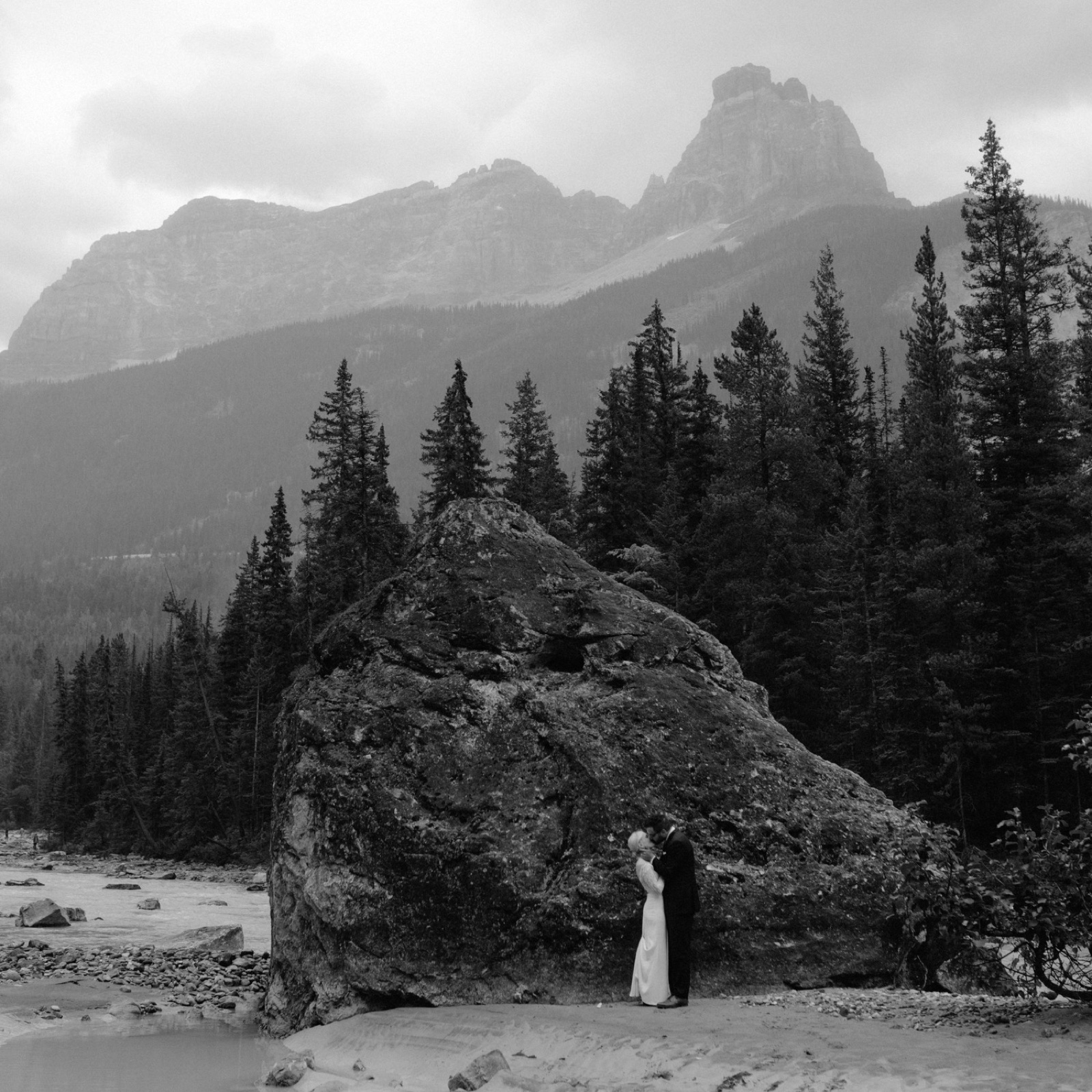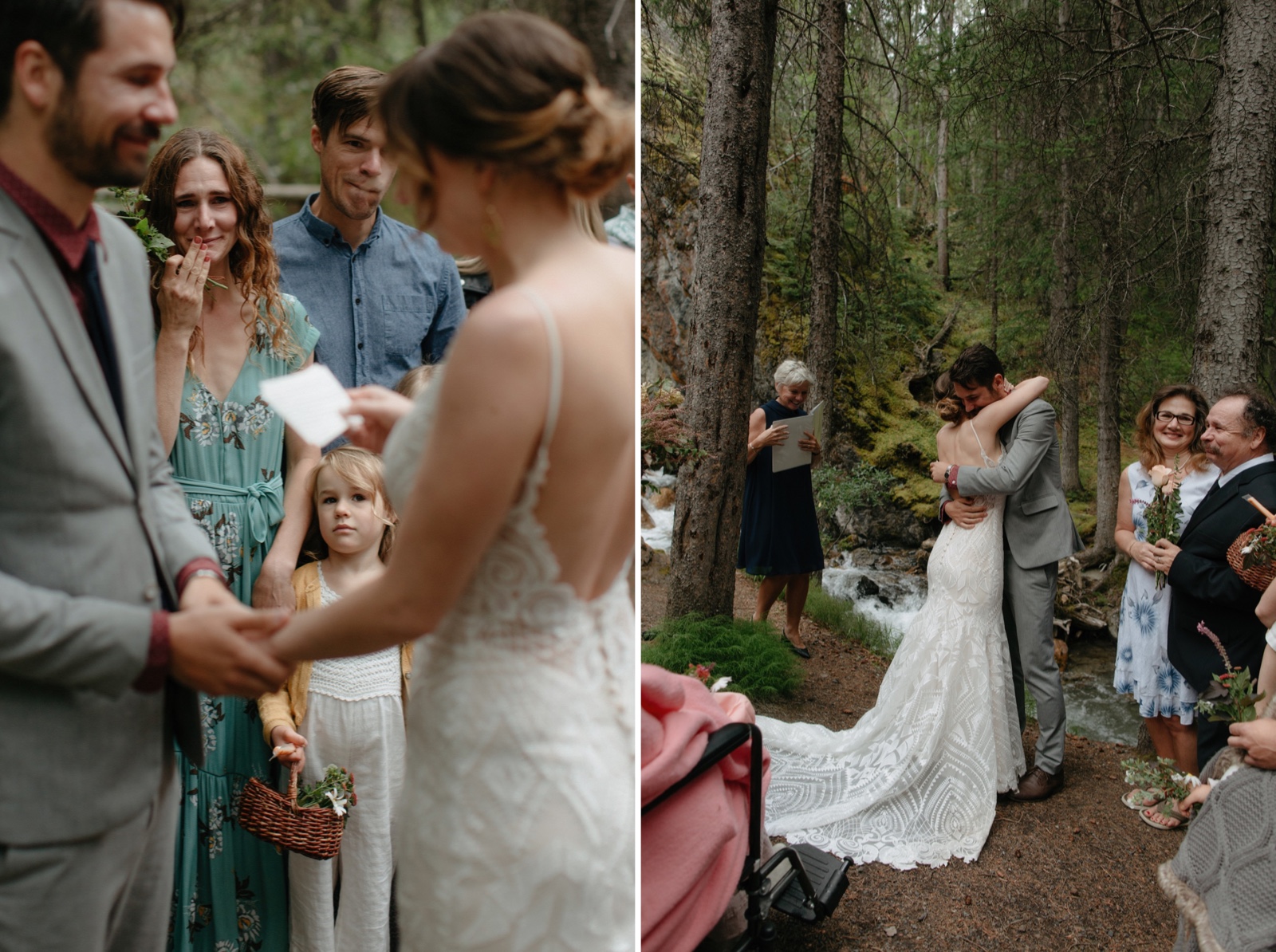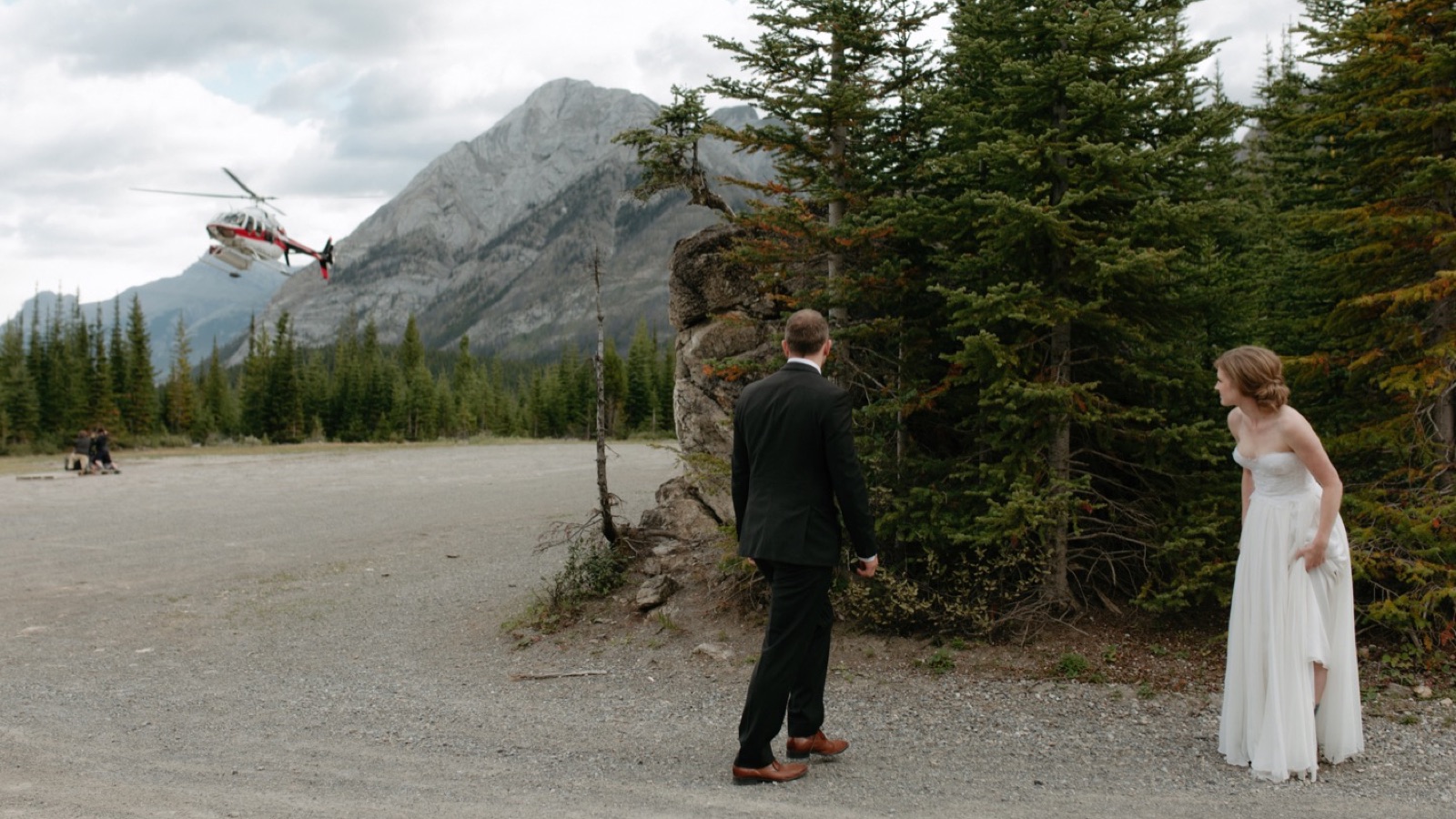Things to Consider when Planning a Hiking Elopement
Banff, Yoho, Kootenay & Kananaskis
So you are planning an intimate wedding or elopement in the Canadian Rockies with a hiking element, that’s so dang exciting! Here are some tips I have put together after helping numerous couples elope in Banff, Yoho and Kootenay National Parks, as well as Kananaskis. Whether you plan to backcountry camp and throw the whole shindig up in a unique location, or get married in a front country lodge and hike for portraits, I hope these tidbits are helpful in planning.
Safety
Safety is hands down the most important part of any hiking wedding or elopement experience. I want you to know that your wedding is just as delightful if it is a short, accessible walk from a parking lot, or is an epic backcountry multi-day hike. It’s important to know your limitations and respect them. I have had hiking days where I have felt matched by a hike I have done easily before. For your elopement, I’d recommend a hike that is easier than your typical comfort level – you’ll likely be carrying more weight in, you may not have slept as well the night before, and you want to fully and entirely enjoy the day.
There are ample resources online to hone your hiking safety knowledge and skills. But in short, avoid wildlife by making your presence known, keep the group together, everyone should be carrying bear spray and know the appropriate response for different types of animal encounters. Pack extra layers, plan your route, bring a map and compass (and don’t rely on your phone’s battery surviving dangnabit), bring more water and food than you think you’ll need plus first aid. Leave word of where you are going and estimated time of being in contact, as well as when your contact should become concerned and what their course of action should be. Check the weather shortly before heading out, keep an eye on the clouds – lightning is a very real threat. In winter do not venture into avalanche terrain without proper training (oh and this exists well into spring on many hikes).
I’m a low to no risk hiker and photographer. Safety is my number one priority and I would rather change go through the short term disappointment of changing hikes, or even your elopement day if timing allows, ensuring the experience is enjoyable.
Time of Year
Typically July and August are Banff and area’s busiest months and that’s for good reason. The weather is warmer, precipitation is less than June, the risk of snowfall is less than in September. That said July and August aren’t a guarantee for good weather. In recent years August has also been wildfire season, and it can snow at any time of the year, particularly at higher elevations.
Trails at higher elevations don’t usually become snow-free until mid to late June, however, there are several beautiful trails particularly in Kananaskis that would be more accessible from mid-May onwards. The iconic lakes of Lake Louise, Moraine Lake, and Emerald Lake thaw throughout May and are usually ice free around the first week of June. From mid-September until mid-October, we enter the shoulder season in the Canadian Rockies. It is perchance my favourite season, there are fewer tourists, the roads to Takakkaw Falls and Moraine Lake remain open, the larches change colour to a brilliant orange (for what feels like a blink, it’s easy to miss when we get the inevitable snowfall), and the peaks get a dusting of snow.
If you are keen on a backcountry camping elopement in the peak season, you’ll need to coordinate with your vendors on dates they are available and coordinate booking your campsites when reservations are available in early January. For a camping elopement, consider how you’ll navigate rain, thunderstorms, or snow. If these things make you nervous perchance consider a hut, or lodge elopement for more shelter, or consider a front-country lodge.
Are you thinking about a winter hiking snowshoe elopement? The best part about winter is the light is gorgeous throughout the day, however, you are more limited on trails that are not in avalanche territory. Lake Louise is typically frozen by mid-November (although sometimes by the first of November), Lake Minnewanka closer to the end of December. The ability to venture out safely on frozen lakes makes for surreal photos, and how neat is it to say you were married in the middle of a lake?
Light, Weather, and Busy Trails (Oh My!)
The best time to take photographs is roughly just before sunrise to one hour after, and two hours before sunset to shortly after. This means for summer weddings or elopements, ceremonies and portraits would ideally be held between approximately 5-7AM, or 8-10PM, which, is understandably a bit undoable for most.
If you have guests who are expecting a later afternoon wedding followed by dinner, perchance discuss with the photographer if they may be available for a day-after session and set up early the next morning or later next evening for portraits. That is what we did for this Banff and Yoho intimate wedding on account of blustery low temperatures on their actual wedding day. It allowed for us to take portraits at our own pace, use the best light as it disappeared down the valley, and for them to spend more time with their family.
But, if you are an early riser, you can beat the crowds on the more popular trails (looking at you Plain of Six Glaciers) and have the views to yourselves and be congratulated by the masses as you meet everyone while heading back to the trailhead. Storms typically roll through in the afternoon and evening in the summer months so you are more likely to stick with your original plans with a morning hike.
Or, consider booking a backcountry campsite, hut, or lodge – do all the hiking work the day before, then do the shorter meander to less busy trails for your elopement ceremony and portraits. Plus, you could read your vows in the morning, celebrate over lunch, then head out later in the afternoon for portraits.
Weight of your Gear
Any hiker knows that you want to pack the necessities, prioritizing safety and preparation for the unexpected. If you imagined a lot of props, an altar that isn’t simply the landscape, a front country elopement or helicopter elopement may be a better idea, and there is nothing wrong with that.
Consider how you will feel about having your elopement ceremony the day of or the day after walking 10km with all your hiking/camping gear. Consider perchance having a friend or two join to help share the load. Know that if you are bringing a photographer or cinematographer, there is a good chance they’ll need an assistant as well to share the load of camping gear in addition to photography gear. Plus, having a group of four or more is better for avoiding wildlife encounters.
Florals
Outdoor enthusiasts should abide by Leave No Trace principles. We want to preserve the places we visit and make sure it remains in all its beauty and the ecology in its natural state for generations to come. For a backcountry elopement or wedding consider not bringing florals in order to not introduce non-native species. If you are wondering how bad could it be, read up on the invasiveness of pampas grass, which is very popular for weddings.
Instead, consider a silk bouquet, or just holding your partner’s hand. Please note, picking of wildflowers is not permitted.
What to Wear
Alright, so the weight of gear is important, as is size. When picking out a suit or dress, consider if it will wrinkle, if it needs to be hung up overnight, will it fit in your backpack or on top of it in a garment bag (and what happens if it is raining). Consider a lighter dress, or one with patterns to hide any slight packing imperfections. Alternative ethical dress brands I recommend are Needle & Thread, Ovate, Sezane, Mara Hoffman, and LACAUSA.
For footwear, of course hiking boots, which will be more than sufficient if you have a longer dress, flip flops (I mean, if you are camping), and practical shoes for portraits. By that I mean I’d highly recommend they have ankle support especially if your ankles are a bit wobbly like mine.
You’re already having an alternative elopement, consider alternative attire for your wedding.
Hair and Makeup
Speaking as someone who can only do a messy bun and nearly never wear makeup, you can do this! Consider learning how to do your own makeup (if this is the case, remember a little pocket mirror), and a simple hairstyle. You can dress it up with a simple 1920s embroidered or beaded hairband.
If the thought of doing your own hair and makeup is terrifying, consult with a local artist. You may be able to have your hair done the day you are hiking to the campground and they can advise you on how to best keep it overnight for the ceremony day. Or, keep things simple and go makeup-free and hair as you normally would!
The Legal Bit
In Alberta, a celebrant must be present with two witnesses for you to legally get married. Of course if you are bringing along photographers or videographers to your elopement in Banff, they will likely be more than happy to witness for you, and I would be happy to recommend celebrants who are willing to hike. Your other option is to legally get married in a more accessible location before or after you hike. Elope in the backcountry and read your vows there, or have a friend officiate a personalized ceremony, sign the paperwork later.
More Canadian Rockies Wedding and Elopement Planning Resources
You may also be interested in these other resources I put together for couples looking to have a wedding or elope in the Canadian Rockies. If you are looking for a wedding or elopement photographer, I would love to hear more about your plans.
Lauren and Brad’s hiking wedding ontop of Mount Fairview beside Lake Louise
Unique Banff, Yoho, Canmore and Kananaskis Venues for a Small Wedding
Banff and Canmore’s Best Private Dining Restaurants for Weddings & Elopements
Best Activities for Wedding Guests Guide in Banff & Canmore
Where to Get Ready for your Wedding in the Canadian Rockies
A Local’s Four Day Itinerary of the Canadian Rockies
Other Banff, Yoho, Kootenay and Kananaskis Hiking Resources
Handbook of the Canadian Rockies by Ben Gadd. This book isn’t for carrying into the backcountry that’s for sure – it is a bit of a behemoth. It is a massive resource on the Canadian Rockies, covering everything from how the mountains formed, to the local history, to wildlife and plants, hiking etiquette, geological data, weather, amongst many other things.
Don’t Waste Your Time in the Canadian Rockies: The Opinionated Hiking Guide by Kathy and Craig Copeland. Hiking guidebooks are expensive so I spent a lot of time researching what would best fit my needs, ultimately I settled on this one. Included is a 340+ page book with stunning photographs (all too important for a photographer), that comprehensively guides you through hikes in Banff, Yoho, Kootenay, Jasper, and Waterton Lakes National Parks. Each hike is rated as premier, outstanding, worthwhile, or don’t do, and are divided between daytrips and backcountry hikes. There are backpack friendly booklets with directions for each hike – far better than relying on your phone for directions when hiking. These past summers I have done numerous hikes solely because of the recommendation of this book and have not yet been disappointed. I have based most of my information provided off of this book and would highly recommend it.








Leave a Reply